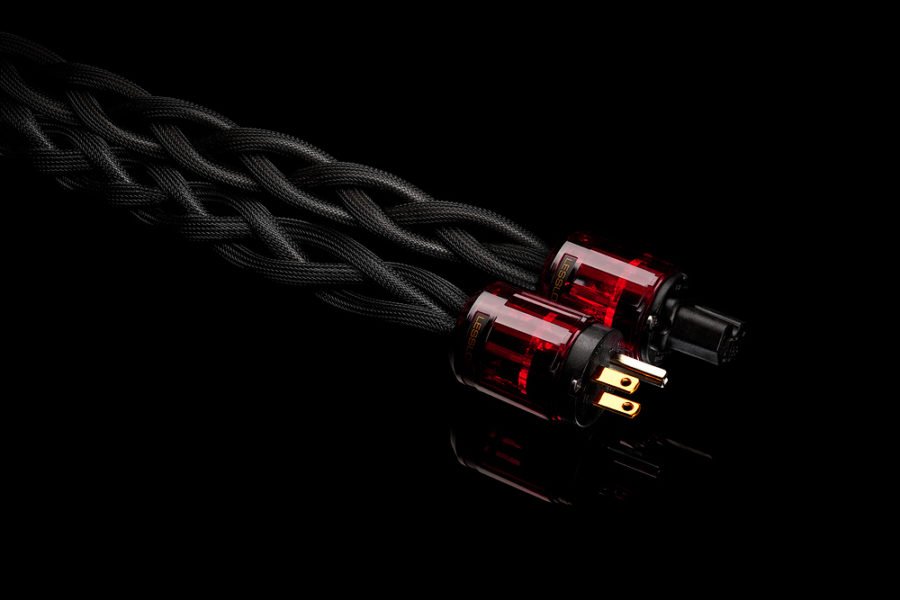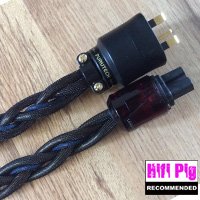Along with the DFPC Signature and DFPC Reference power cables that I had in for review last year I also had the DFPC Originals. Costing a fair bit less than the other models coming in at $595 for any length up to 2 
metres and only costing a small amount more for longer lengths. The cables can be terminated with standard or high current IEC’s from Oyaide and are available with any variation of power plugs from Oyaide or a Furutech 1363 (G) for the UK and Japan.
Geometrically, the DFPC Original has a 3 core plaited construction and like other LessLoss power cables is extremely well made and solid in construction. Flexibility of the cable is very good due to its geometry and is more easily routed than first perceptions would leave one to believe as its size is slightly toward the larger size.
The DFPC Original is constructed from 6mm2 copper conductors with a level 1 ‘Skin Filtering’ technique applied to them. DFPC Signature has level 2 and DFPC Reference a level 4 Skin Filtering, more on LessLoss’ Skin Filtering is available from their website pages but needless to say the processes are time consuming processes which has an effect how long it takes to produce the power cables, taking many days in some cases claims LessLoss.
THE SOUND
I have been incredibly impressed with the DFPC Signature and DFPC Reference cables, each being a defined step up in performance from the previous. The DFPC Original though is a truly fantastic cable at a very reasonable price which has a firm relation in performance to the other two ranges.
The DFPC Originals promote delicacies in the performance very well and Ed Sheeran’s guitar strings really came to life during his ‘Tenerife Sea’ performance conveying intricacy and naturalness. The black background I was used to in my system didn’t seem to have changes at all proving that the Originals didn’t allow for any airborne nasties to be introduced into the system and Sheeran’s vocal was on the money for me with a great range of tone.
Whilst not exploring the vast open and extreme airiness of say the Reference cable in upper frequencies I felt that the Original traded off the absolute refinement for a little bit more of an edgier aura of excitement and pizzazz with rock and dance recording where absolute refinement takes away the fun in these types of genres, in fact they were pretty much on the money.
Not taking away from how good the Original is with ‘proper’ music violins and cymbals were very palpable and the cables didn’t seem to restrict spacious decay bringing a sense of realism that was clearly noticeable during playback.
Listening to Urban Species ‘Blanket’, bass notes were full and allowed for the tracks large lower end to be truly conveyed with all of its masculine weight and extension which never over-shadowed the sultry vocal conveying all the appeal of the dark smokey back street bar the track was set in.
The Originals seem to strike this wonderful balance where gritty meets sultry, rough meets smooth and tight meets loose, the overall presentation has a balance which I could refer to as very universal and the cables could be an extremely easy integration into most systems especially where a range of genres are listened to often.
I replaced the power cable I was using from the wall with a DFPC Signature as LessLoss’ Louis Motek suggests that if making a single cable upgrade to use that cable from the wall to the distribution block.
Effects were well received, the cables have and had a clear synergy and refinement increased allowing for upper end micro details and micro dynamics to become more apparent and bass notes had more upper bass information. Where ‘Blanket’ sounded full and a little loose with great extension, now the upper bass registers had more definition and detail.
Overall soundstage width with the Originals in place was as vast as I’m used to although some of the borders intricacies had been masked and their ‘firefly like’ bouncy nature had become slightly intoxicated. DFPC Signature sobered them up a little and they began to sound a little more playful in comparison.
CONCLUSION
Using DFPC Originals throughout a system is a sure fire way of fitting excellent cables which I believe to be great value for money, (the plugs alone are really quite expensive) that will wow the listener and not have them drawn to any particular aspects of the music in a critical manner, they just enthuse the music and across a vast range of genres have a good tonal balance.
Introducing a DFPC Signature will enhance smaller details and refinement but in turn draw the listener to other aspects over a period of time in a more critical manner, this is a constant threat with equipment and cables alike in high end audio and is definitely not a factor specific to LessLoss, so don’t get this statement confused.
My bottom line is the DFPC Originals are the baby of the line but what they may lack in ultimate refinement and detail retrieval they more than make up in musicality, balance and flexibility of synergy with equipment and music alike.
Build Quality – 8.7/10
Sound Quality – 8.4/10
Value For Money – 8.6/10
Overall – 8.56/10
Recommended for their price/performance level and flexibility of synergy with musical genres and equipment.
As the cable under review here has achieved a score greater than 8.5 out of a possible 10 marks, our policy at Hifi Pig is then to forward it to another reviewer, in this case Dominic, who casts his views about the product.
Lessloss hail from US and produce a number of power cables, interconnects, speaker cables, digital interconnects, a firewall mains conditioning unit and digital source components (A streamer and DAC).
Here under review is their “Original” power cord which lies at the bottom of their 3 tiered power cord range. The Signature cord was reviewed by Hifi Pig in January 2014 by Dan Worth and the Reference was also reviewed by him in June 2014, both of which won his approval.
CONSTRUCTION
Outwardly, the Lessloss Original appears to be a plaited 3 wire weave of equal sized conductors and clothed in a black expandable mesh covering. It looks very simple, but getting the plait weave to this level of accuracy and consistency is not easy by any means. The review sample was fitted with a Schuko mains plug from Oyaide at the ‘input’ end while at the ‘output’ end there is a large bodied Oyaide IEC connector, which by the way are genuine Oyaide connectors. Other terminations are available to order.
No other details about construction was supplied directly to Hifi Pig by Lessloss, so I spent some considerable amount of time ploughing through the copious amount of information on the Lessloss website, yet at the end of that I am still none the wiser regarding conductor metallurgy or insulation materials. A vast amount of explanation about “skin filtering” but even then not explaining how that is implemented within the cable itself, not that Lessloss are obliged to inform any of us of course, so that makes what is written there rather irrelevant with regards to this review, especially so when I disagree with some of the statements being made there.
No matter, whether the cable is made from spaghetti or any other material, what concerns us here is the actual sound produced by the Lessloss Original power cord, so herewith is my perception of its performance.
SOUND QUALITY
My first impression of the sound then can be encompassed within only one word – SOLIDITY. From that first note onwards everything sounded solid and complete, wanting for nothing obvious in the sounds I heard. The sound seemed almost constructed of granite, so that the shape of notes was defined within an envelope that had textures and layers within too, with the power and weight that should be there, was there, yet never once excessive or overblown, with not a trace of overhang or muddling. It was that same absence of overhang that gave the impression that the music had slowed down, because once the bass note ceased, I was greeted by a swift silence between the notes so the end of one note and the commencement of the next seemed longer because of that brief pause. That silence was indeed ‘silent’, as background noise just wasn’t there, a dark quiet that shows the cable itself isn’t introducing hiss or hum into the system.
Talking of silence, I then played no music at all and cranked the volume right up to full for my noise test. This is to see if there is any hiss, hum or other unwanted artifacts being introduced by the cable itself and none was heard at all in my system, which is sensitive and will show these faults immediately.
When it comes to fast transients however, this cable wasn’t quite as nimble and agile as others I have heard. Snare drum hits slightly lacked the crisp razor sharp “crack” from the leading edge of wooden stick striking skin and couldn’t quite convincingly convey the sounds coming from the shell of the drum itself heard immediately behind the strike either. It still sounded like a snare drum being hit with a wooden stick though nonetheless. Kick drum was recreated accurately and I could clearly tell if a soft or hard face was being used on the beater, with the weight and power of the strike easily discernable so the full power was there to be heard.
I found the treble to be very natural and organic which is my own personal preference, rather than being spotlit and etched sounding, as over illuminated treble really does make me wince. Cymbal strikes had a crisp metallic “ting” to them with the decay shimmer of the instrument heard clearly and the high hat was very easy to follow with any genre of music, particularly so with high energy or frenetic rock music which often drowns out this instrument.
The mid band too was also a pleasant organic natural sound, so female vocals were clear and uncluttered, soft and beguiling with soft undertones easily heard. Male vocals had the throaty bass growl where needs be and in particular Mark Knopfler’s voice had it’s gravelly texture as it should be too, so this cable met all my standard sonic benchmarks.
Moving on to some music, I played Porcupine Tree’s “Deadwing” album which for me sorts out who’s who when it comes to cables. The beginning of the title track has various screeches and squealing noises for the casual listener which is in fact the sounds of an Underground train arriving at a station and passengers alighting. Cables not quite up to the mark gives only the screeching and squealing noises, omitting or muffling the other sounds and leaving the listener rather baffled as to what the sounds actually are, so the Lessloss cable left me in no doubt that all the sounds were present and correct. The track then picks up pace and can sound rather raucous and frenetic, instruments crashing into one another too, unless it’s under perfect control so all the subtle layering is unfolded. At 6 minutes 40 seconds into the title track there is a long low bass note which must ‘roll’ outwards from the speakers and that is the best way I can describe the sound, because there should actually be a wave shape of sound. With the Lessloss Original all sounds were conveyed as anticipated so another plus mark from me here.
Time for some gentler music perhaps with acoustic sounds, so in to the CD drawer went Derrin Nauendorf’s “Live at the Boardwalk” CD which is recorded live, close mic’d with only a simple drum kit accompaniment. Derrin’s voice on this album leaves a lot to be desired in places (no offence Derrin fans – which I am one), but it’s his superb guitar playing that compels me to listen to him performing again and again, so I do favour the instrumental parts of the album rather than the vocals I must admit. Derrin’s guitar plucks, strums and finger work on the frets was recreated with startling reality and I could clearly distinguish between steel and nylon strings on his guitar, with the rich tones of the instrument’s body also shining through. There was never a clash either between drums and guitar, so the whole performance remained cohesive and very easy to listen to.
CONCLUSION
All in all then, a fine performance from a mains cable that does what it says on the tin – allows the system to breathe and perform at it’s best. It really is a product that you set to it’s task and it will quietly and efficiently give a solid uncluttered sound without drawing attention to itself, so it is truly a “fit and forget” component – which I nearly did until I realised it had to be returned to Lessloss following the review!
Construction: 8.6/10
Sound quality: 8.6/10
Value for money: 8.3/10
Overall: 8.5/10
Recommended for: Providing a no-nonsense, powerful, and solid sound.
Price at date of test: $595.00 including shipping




















































































































































































You must be logged in to leave a reply.